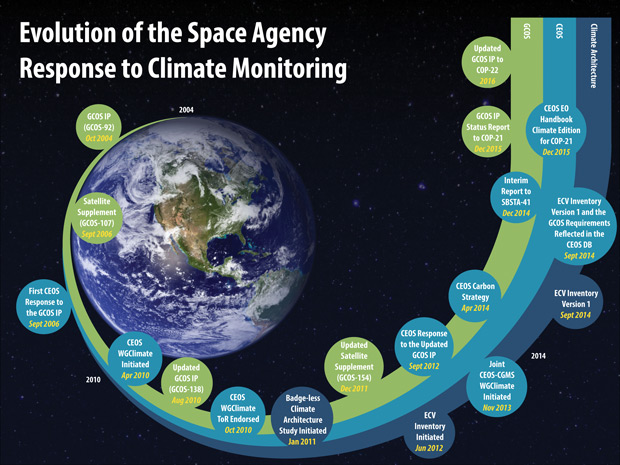|
|
|
 |
 |
 |

|
 |
As explained here, the cooperation between CEOS and GCOS to define the information requirements needed by UNFCCC and its Parties, and to help plan the implementation of the satellite observing systems needed, is fundamental to the success of the Convention in implementing, managing and measuring the effectiveness of any agreement reached in Paris, as well as the related policies aimed at mitigation and adaptation to climate change.
The WGClimate is the centre-piece of CEOS’ contribution to climate change monitoring. This group, a joint group including CEOS Agencies and the Coordination Group for Meteorological Satellite (CGMS), coordinates and encourages collaborative activities between the world’s major space agencies in the area of climate monitoring with the overarching goal to improve the systematic availability of Climate Data Records through the coordinated implementation and further development of a global architecture for climate monitoring from space.
Architecture for Climate Monitoring from Space
CEOS/CGMS WGClimate has collaborated with GCOS and WMO to develop a strategy report that focuses on satellite observations for climate monitoring from space and the need for an international architecture that ensures delivery of these observations over the time frames required for analysis of the Earth’s climate system. The report outlines a strategy for such an architecture – a strategy that is intentionally high-level, conceptual, and inclusive so that broad consensus can be reached and all relevant entities can identify their potential contributions. The first step is to document current capabilities through a systematic and granular assessment of the production of the Thematic Climate Data Records at the level of individual agencies – producing an inventory of Essential Climate Variables (ECV).
The ECV Inventory
CEOS, CGMS, and WMO have initiated an inventory of the space agency datasets that make up the structure of the climate monitoring architecture for space-based observations. This inventory will inform specific analyses of and decisions about climate observations across all CEOS and CGMS Agencies, to include:
- Maintaining awareness of the current and planned monitoring capability on an ECV basis across all Agencies
- Defining an optimum “macro-scale” space system configuration and its components
- Identifying gaps and shortfalls at the ECV/product level
- Coordinating action plans to address identified gaps
- Triggering of medium-term activities needed to sustain the long-term implementation of the architecture
By linking this information to the core missions, instruments, and measurements information maintained routinely by CEOS, the world’s space agencies hope to assemble powerful insights into the satellite mission planning required to ensure sustained provision of the ECVs specified by GCOS for the UNFCCC.
The evolution of the space agency response to climate monitoring is summarised in the figure shown - with a focus on the CEOS-GCOS relationship and the key documents provided to the UNFCCC.

This chapter of the Earth observation handbook provides detailed information on: the nature of the GCOS requirements; of the Essential Climate Variables; the actions specified by CEOS/CGMS to address them; and the status of these actions as reported periodically to UNFCCC. When available, this will include the ability to access the ECV inventory online directly to determine the status and maturity of individual ECVs and related climate data records. The ECV inventory is anticipated to be available online and linked to the CEOS Database some time in 2016. The tables of GCOS ECVs, global data products, and CEOS actions are available at the CEOS Database Climate chapter here.
|
 |
|
|
|
|